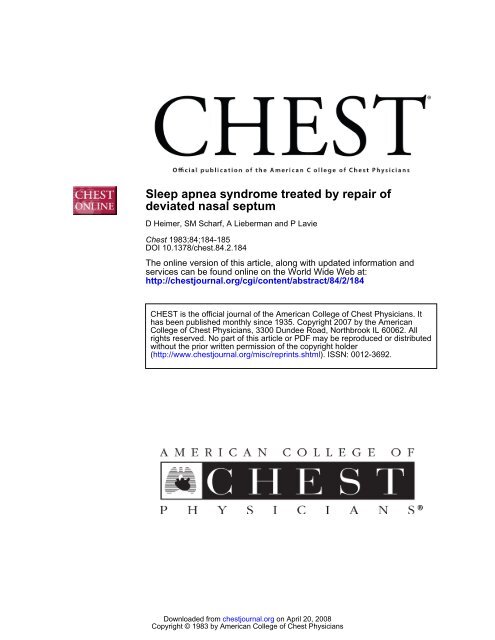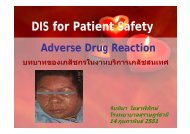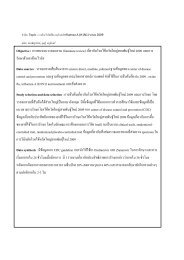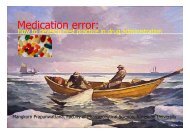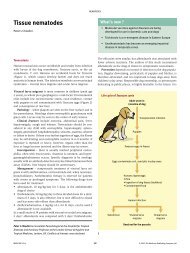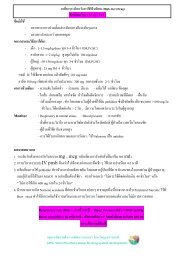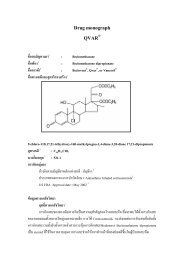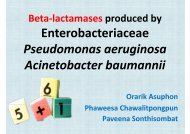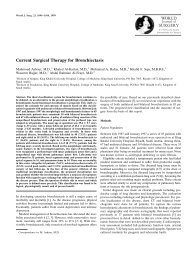D Heimer, SM Scharf, A Lieberman and P - Thaiwonders
D Heimer, SM Scharf, A Lieberman and P - Thaiwonders
D Heimer, SM Scharf, A Lieberman and P - Thaiwonders
Create successful ePaper yourself
Turn your PDF publications into a flip-book with our unique Google optimized e-Paper software.
Sleep apnea syndrome treated by repair of<br />
deviated nasal septum<br />
D <strong>Heimer</strong>, <strong>SM</strong> <strong>Scharf</strong>, A <strong>Lieberman</strong> <strong>and</strong> P Lavie<br />
Chest 1983;84;184-185<br />
DOI 10.1378/chest.84.2.184<br />
The online version of this article, along with updated information <strong>and</strong><br />
services can be found online on the World Wide Web at:<br />
http://chestjournal.org/cgi/content/abstract/84/2/184<br />
CHEST is the official journal of the American College of Chest Physicians. It<br />
has been published monthly since 1935. Copyright 2007 by the American<br />
College of Chest Physicians, 3300 Dundee Road, Northbrook IL 60062. All<br />
rights reserved. No part of this article or PDF may be reproduced or distributed<br />
without the prior written permission of the copyright holder<br />
(http://www.chestjournal.org/misc/reprints.shtml). ISSN: 0012-3692.<br />
Downloaded from chestjournal.org on April 20, 2008<br />
Copyright © 1983 by American College of Chest Physicians
Sleep Apnea Syndrome Treated by Repair of<br />
Deviated Nasal Septum*<br />
Dov <strong>Heimer</strong>, M.D.; Steven M. <strong>Scharf</strong> M.D.; Alberto <strong>Lieberman</strong>, M.D.;<br />
<strong>and</strong> Peretz Lavie, Ph.D.<br />
Sleep apnea syndrome (SAS) often presents a difficult<br />
therapeutic problem to the clinician since many of the<br />
accepted modes of therapy are associated with only partial<br />
success or with a number of long-term complications. We<br />
present three patients with obstructive SAS in whom dramatic<br />
clinical improvement occurred following repair of a<br />
deviated nasal septum. The subjective improvement was<br />
associated with a diminution in the number <strong>and</strong> duration of<br />
obstructive apnea episodes as observed during a st<strong>and</strong>ard<br />
sleep study. Because ofits simplicity <strong>and</strong> low rate of complication,<br />
we propose that repair of a deviated nasal septum be<br />
further evaluated as a mode of therapy for this condition.<br />
Sleep apnea syndrome (SAS) is characterized by<br />
recurrent apnea during sleep, primarily during<br />
stages 112 in non-REM sleep. The apnea lasts more<br />
than 10 seconds <strong>and</strong> occurs more than 30 times per<br />
sleep period.’ Clinically, there is heavy snoring during<br />
sleep, excessive daytime somnolence, decreased intellectual<br />
capacity, <strong>and</strong> in approximately half the cases,<br />
obesity. There are three types of apnea: central, in<br />
which all breathing eflbrts cease; peripheral, in which<br />
breathing efforts continue, but air flow ceases as a<br />
result ofupper airway obstruction; <strong>and</strong> mixed, in which<br />
central-type apnea evolve into the obstructive type.<br />
The apneic episodes are often associated with hypoxemia<br />
<strong>and</strong> arousals. ‘Theatment modalities include:<br />
weight loss,2 tracheostomy to bypass the upper airway<br />
obstruction,’ <strong>and</strong> respiratory stimulants such as progesterone,4<br />
<strong>and</strong> protryptyline.’ However, there are<br />
major difficulties with each ofthese modes of therapy.<br />
Weight loss by diet is often unsuccessful because of<br />
poor patient cooperation. Long-term tracheostomy is<br />
fraught with complications,6 <strong>and</strong> drug therapy is at best<br />
only partially successful.4” Thus, alternate modes of<br />
therapy must be sought.<br />
We present three patients with documented SAS in<br />
whom dramatic clinical improvement occurred followmg<br />
repair of a deviated nasal septum. This clinical<br />
improvement was associated with a decrease in the<br />
number <strong>and</strong> duration ofapneic episodes measured in a<br />
st<strong>and</strong>ard sleep study.<br />
MATERIALS AND METHODS<br />
Whole night polysomnographic recordings were performed in the<br />
conventional way. Variables measured included EEG, electrooculogram,<br />
<strong>and</strong> electromyogram (recorded from the sternocleidomastoid);<br />
the sleep periods were seven hours. Sleep stages were<br />
scored according to st<strong>and</strong>ard criteria.7 Respiratory movements were<br />
detected by the use ofa strain gauge respiratory belt tied around the<br />
Fmm the Division ofLung Diseases, <strong>and</strong> Department ofEar Nose<br />
<strong>and</strong> Throat, Soroka Medical Center, <strong>and</strong> Faculty of Health<br />
Sciences, Ben Gurion University of Negev, Beersheba, <strong>and</strong> Sleep<br />
Laboratory, Technion, Haifa, Israel.<br />
Manuscript received December 6; revision accepted March 28.<br />
lower thorax, <strong>and</strong> air flow at the nose <strong>and</strong> mouth was detected by use<br />
of nasal <strong>and</strong> oral thermistors.<br />
Each patient underwent a complete ear, nose, <strong>and</strong> throat examination.<br />
The extent ofobstruction to the nares was estimated clinically.<br />
Nasal septal repair was done by a st<strong>and</strong>ard submucosal resection<br />
performed under local anesthesia.<br />
All patients underwent lung function testing including measurements<br />
of forced expiratory flows, lung volumes, <strong>and</strong> ventilatory<br />
responsiveness to CO,.<br />
CASE 1<br />
A 56-year-old man of European extraction was referred to the<br />
pulmonary clinic because ofcontinually falling asleep at his job <strong>and</strong><br />
loud snoring at night. Physical examination revealed: weight-.ll0<br />
kg, approximately 80 percent obstruction of the right nostril by a<br />
deviated septum, <strong>and</strong> a normal cardiopulmonary system. Pulmonary<br />
function testing was normal. A sleep study revealed approximately<br />
300 episodes of apnea with an average duration of 25 sec. Approximately<br />
60 percent of the apneas were peripheral. The patient was<br />
unable to follow a weight reduction diet. A six-week trial of therapy<br />
with medroxyprogesterone acetate (80 mg a day in four divided<br />
doses)failed tolead to clinical improvement. Fullpatencyofthe right<br />
nostril was restored following repair of the deviated septum. The<br />
patient noticed a marked clinical improvement in his symptoms with<br />
almost complete disappearance of his daytime somnolence. Repeat<br />
sleep study eight weeks fullowing surgery showed that the number of<br />
apneas was now 106 per sleep period with an average duration of 15<br />
sec. At the time of his sleep study he was receiving no medication<br />
<strong>and</strong> his weight was unchanged.<br />
CASE 2<br />
A 44-year-old man of North African origin presented to the<br />
pulmonary service complaining of excessive daytime sleepiness.<br />
Because of the frequent napping, he was forced to quit his job as a<br />
construction worker. He also had loud nightime snoring, <strong>and</strong><br />
impotence. Physical examination revealed: weight-119 kg, complete<br />
obstruction ofthe left nostril, <strong>and</strong> a normal cardiopulmonary system.<br />
Pulmonary function testing was normal. The patient could not follow<br />
adiet, <strong>and</strong> an eight-week trial ofmedroxyprogesterone(80 mg/day in<br />
four divided doses) failed to lead to clinical improvement. Sleep<br />
study revealed 290 apneas per sleep period with an average duration<br />
of 25 sec, 80 percent of which were peripheral. Following submucosal<br />
resection of the deviated septum, examination revealed<br />
nearly complete patency ofthe left nasal passage. Within two weeks<br />
of surgery, the patient noted a marked diminution of the daytime<br />
somnolence. A repeat sleep study done six months following surgery<br />
showed that the number ofapneas per sleep period had decreased to<br />
184 Sleep Apnea Syndrome <strong>and</strong> Deviated Nasal Septum (Helmarat a!)<br />
Downloaded from chestjournal.org on April 20, 2008<br />
Copyright © 1983 by American College of Chest Physicians
40 with an average duration of 15 sec. By that time, the patient<br />
resumed a normal working life <strong>and</strong> his sexual function had returned.<br />
His weight remained essentially the same as at the initial examination<br />
<strong>and</strong> he was taking no medications.<br />
CASE 3<br />
A 40-year-old diabetic man ofNorth African origin was referred to<br />
the pulmonary service because of severe nighttime snoring, <strong>and</strong><br />
excessive daytime sleepiness to the point ofinterfering with his work<br />
as a glass worker. Examination revealed: weight, 70 kg; complete<br />
obstruction ofthe left nostril; <strong>and</strong> a normal cardiopulmonary system.<br />
Sleep study showed 350 apneas per sleep period with an average<br />
duration of 40-50 sec, all of which were peripheral. Within two to<br />
three weeks following submucosal resection of the septum, the<br />
patient noted dramatic diminution in his daytime somnolence.<br />
Repeat sleep study performed 12 months following surgery showed<br />
dramatic improvement with only 40 apneas per sleep period, most of<br />
which were central. At the time ofthe repeat sleep study, his weight<br />
was 71 kg <strong>and</strong> the patient was receiving no medication.<br />
A further point of note is that all three of these patients were<br />
observed to be nasal breathers on the sleep examination as shown by<br />
the pattern ofair flow in the nasal <strong>and</strong> mouth thermistors.<br />
DISCUSSION<br />
The three SAS patients described here responded<br />
clinically <strong>and</strong> objectively to repair of a deviated nasal<br />
septum. It should be noted that none ofthese patients<br />
complained ofobstructed breathing or any other nasal<br />
symptoms. In two, weight loss <strong>and</strong> treatment with<br />
medroxyprogesterone acetate was unsuccessful. There<br />
are a number of reports in the literature describing an<br />
association between upper airway obstruction <strong>and</strong><br />
breathing disturbances during sleep. Nasopharnygitis<br />
in children, for instance, is associated with an increase<br />
in the frequency <strong>and</strong> duration of apneic spells during<br />
sleep.8 Simons et al9 described a case of hypersomnia<br />
associated with nasal septal deviation which was successfully<br />
treated with submucosal resection. However,<br />
data from a post-surgery sleep study were not provided.<br />
The same authors also reported that repair of<br />
the nasal septum did not improve the condition of<br />
three other patients’#{176} suffering from SAS. Several<br />
authors have found that sleep disturbances occur in<br />
normal subjects following temporary occlusion of the<br />
nares. Zwillich et al” demonstrated a decrease in the<br />
depth ofsleep <strong>and</strong> an increase in the number of apneic<br />
episodes with complete nasal occlusion. Lavie et al”<br />
showed an increase in the number of microarousals<br />
associated with nonapneic breathing <strong>and</strong> an increase in<br />
the amount of awake time during the sleep period of<br />
subjects under these circumstances. Data from the<br />
same laboratory’3 also demonstrated that in two-thirds<br />
of their sleep apneic hypersomnolent patients, physical<br />
examination revealed an upper airway abnormality<br />
(nasal septal deviation, hypertrophy of the adenoids,<br />
etc). Several of these patients, ie, those suffering from<br />
hypopneas during sleep, improvement in symptoms<br />
<strong>and</strong> sleep study was noted following nasal septal repair.<br />
Regarding the mechanism of improvement in SAS<br />
following repair of the nasal septum, there are at least<br />
two possibilities: upper airway obstruction could lead<br />
to apneas via disturbed reflex mechanisms, possibly<br />
trigeminally or vagally mediated, which normally act<br />
to preserve airway patency in the presence of negative<br />
pressure in the upper airway;’4 <strong>and</strong> direct mechanical<br />
effects-with obstruction of the upper airway the<br />
pressure gradient for airflow increases <strong>and</strong> the pressures<br />
within the upper airway become more negative<br />
relative to atmospheric. This could lead to a greater<br />
tendency for airway closure. Ifthis were the case, then<br />
it would be expected that a nasal as opposed to oral<br />
breathing pattern would predispose to the development<br />
of apnea during sleep. All three of our patients<br />
demonstrated nasal breathing during their sleep studies,<br />
which is consistent with direct mechanical effects<br />
as being the mechanism of production of apneas.<br />
A potential advantage of repair of a deviated nasal<br />
septum in the treatment of SAS is its very low rate of<br />
complication <strong>and</strong> it can be performed under local<br />
anesthesia. Furthermore, even partial success may be<br />
worthwhile <strong>and</strong> obviate the need for other modes of<br />
treatment. On the basis ofour observations, therefore,<br />
we recommend that repair of a deviated nasal septum<br />
should be further evaluated as a form oftherapy in the<br />
treatment of symptomatic sleep apnea syndrome.<br />
REFERENCES<br />
1 Guilleminault C, ‘fllkian A, Dement WC. The sleep apnea<br />
syndrome. Ann Rev Med 1976; 27:465-84<br />
2 Fairman RP, Sugerman HJ. Gastroplasty for obstructive SAS <strong>and</strong><br />
morbid obesity. Am Rev Respir Dis 1982; 125:108 (suppl)<br />
3 GuilleminaultC, Simmons B, MottaJ, CurnmiskeyJ, Roskind M,<br />
Schroeder J, et al. Obstructive SAS <strong>and</strong> tracheostomy. Arch<br />
Intern Med 1981; 141:985<br />
4 Sulton FD, Zwillich CW, Creagh CE. Progesterone for out<br />
patient treatment of Pickwickian syndrome. Ann Intern Med<br />
1975; 83:476-79<br />
5 Conway W, Roth T, Zonick F Protryptyline therapy for upper<br />
airway sleep apnea. Am Rev Respir Dis 1982; 125:102 (suppl)<br />
6 Conway WA, Victor LD, Donald J, Magilligan J, Fugita S, Zorick<br />
FJ, et al. Adverse effect of tracheostomy for SAS. JAMA 1981;<br />
246:347<br />
7 Rechtchaffen A, Kales A. Manual of st<strong>and</strong>ardized terminology,<br />
techniques <strong>and</strong> scoring system for sleep states ofhuman subjects.<br />
Washington DC (NIH publication No. 204), 1968<br />
8 Steinschneider A. Nasopharyngitis <strong>and</strong> prolonged sleep apnea.<br />
Pediatrics 1975; 56:967<br />
9 Simons FB, Hill MW. Hypersomnia caused by upper airway<br />
obstruction. Ann Otol 1974; 83:670<br />
10 Simons FB, Guillerninault C, Dement WC, ‘.fllkian A, Hill N.<br />
Surgical Management of airway obstruction during sleep.<br />
Laryngoscope 1977; 87:326<br />
U Zwillich CW, Pickett C, Hanson FN, Weil JV. Disturbed sleep<br />
<strong>and</strong> prolonged apnea during nasal obstruction in normal men. Am<br />
Rev Respir Dis 1981; 124:158<br />
12 Lavie P, Fischel N, Jomer J, Eliaschar I. The effect ofpartial <strong>and</strong><br />
complete mechanical occlusion of the nasal passage on sleep<br />
structure <strong>and</strong> breathing in sleep. Acta Otolaryngol (Stockholm)<br />
1982 (in press)<br />
13 Lavie P, AIroy G, Halpern E. Apneic <strong>and</strong> non-apneic breathing<br />
disorders in sleep. Israel J Med Sci 1982; 18:523-33<br />
14 Mathew OP, Abu-Osba YK, Thach BT Influence ofupper airway<br />
pressure changes on genioglossus muscle respiratory activity.<br />
J AppI Physiol 1982; 52:438-44<br />
CHEST I 84 I 2 I AUGUST, 1983 185<br />
Downloaded from chestjournal.org on April 20, 2008<br />
Copyright © 1983 by American College of Chest Physicians
Sleep apnea syndrome treated by repair of deviated nasal septum<br />
D <strong>Heimer</strong>, <strong>SM</strong> <strong>Scharf</strong>, A <strong>Lieberman</strong> <strong>and</strong> P Lavie<br />
Chest 1983;84;184-185<br />
DOI 10.1378/chest.84.2.184<br />
This information is current as of April 20, 2008<br />
Updated Information<br />
& Services<br />
Citations<br />
Permissions & Licensing<br />
Reprints<br />
Email alerting service<br />
Images in PowerPoint format<br />
Updated information <strong>and</strong> services, including high-resolution<br />
figures, can be found at:<br />
http://chestjournal.org<br />
This article has been cited by 1 HighWire-hosted articles:<br />
http://chestjournal.org<br />
Information about reproducing this article in parts (figures,<br />
tables) or in its entirety can be found online at:<br />
http://chestjournal.org/misc/reprints.shtml<br />
Information about ordering reprints can be found online:<br />
http://chestjournal.org/misc/reprints.shtml<br />
Receive free email alerts when new articles cite this article sign<br />
up in the box at the top right corner of the online article.<br />
Figures that appear in CHEST articles can be downloaded for<br />
teaching purposes in PowerPoint slide format. See any online<br />
article figure for directions.<br />
Downloaded from chestjournal.org on April 20, 2008<br />
Copyright © 1983 by American College of Chest Physicians


